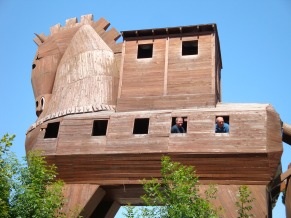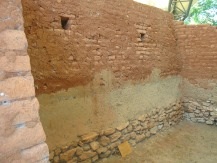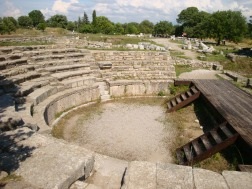Setting for Homer’s Iliad
Of all the hundreds of archaeological sites in Turkey, the one that is probably best-known around the world is Troy. Not surprisingly, the site, on the Northern Aegean near Çanakkale, is one of the country’s world heritage sites.
Backstory
Long before Brad Pitt and Orlando Bloom brought Troy to the big screen in 2004, the 10-year Trojan War, as described in Homer’s Iliad, was one of those moments in history that everyone seems to know about.
How Aphrodite awarded the Trojan prince Paris the gorgeous Helen as a prize for judging her the most beautiful Greek goddess. How Paris stole Helen from her husband. How Menelaus besieged Troy to try and win her back. How the war dragged on and on until the Greek troops finally thought of leaving a huge wooden horse full of soldiers outside the gates of Troy. How the Trojans foolishly dragged the horse inside, thereby bringing about their doom.
Few stories have gripped the imagination like that of Troy, with the rulers of medieval Italy and even Britain tracing their ancestry back to Aeneas, one of the heroes who sailed away from the city after its eventual fall. That had surprising consequences for Turkey, where the Ottomans were keen to present themselves as natural successors to the Byzantine emperors, who, in turn, saw themselves as the successors to the Roman emperors. According to that logic, the link with Aeneas looped back to Turkey, and Mehmed the Conqueror is said to have visited the supposed site of Troy in 1462 and contemplated establishing his capital there.
Troy, then, is a site that carries a great weight of history and mythology on its shoulders. Unfortunately, the ruins that greet visitors today struggle to live up to what is expected of them. Troy is no Ephesus, where even those with little knowledge of archaeology can readily imagine the busy city that once stood on the site. Instead, it’s basically a large mound with the remains of some nine lost cities sitting on and around it.
The ninth and final city on the site was Roman. However, not a great deal remains to be seen of it, not least because the attention of early archaeologists tended to focus on the hunt for the much earlier Troy of Homer and the heroes.

Although it is the German businessman-turned-archaeologist, Heinrich Schliemann (1822-90), who garners the headlines for having found Homer’s Troy, in fact it was the rather less self-serving British consul-cum-archaeologist, Frank Calvert (1828-1908), who first identified a mound named Hisarlık, near Çanakkale, as the probable site of Troy.
Schliemann then obtained permission to dig it up, going on to slice trenches right through the layers of habitation that lay beneath the soil to identify first what is now called Troy I, then Troy II, as Homer’s city (nowadays Troy VI, which lasted from c.1700 to c.1250 B.C., is the preferred candidate).
At some point he claimed to have uncovered a cache of gold that he dubbed Priam’s Treasure after the king of Troy at the time of Helen’s abduction. This he smuggled out of Turkey and eventually sold to Germany, whence it was seized by the Russians at the end of World War II. For the time being, it languishes in the Pushkin Museum of Fine Arts in Moscow, claimed by Turkey but not, as yet, returned.
Around the site
 Today, a route round the site has been marked out with everything clearly labelled. Specific features to look out for include sturdy walls of stone and brick; the remains of a sanctuary probably devoted to the gods of Samothrace, which is visible on the horizon; the ruins of a palace; a dramatic ramp; and a small Classical odeon or mini-theatre.
Today, a route round the site has been marked out with everything clearly labelled. Specific features to look out for include sturdy walls of stone and brick; the remains of a sanctuary probably devoted to the gods of Samothrace, which is visible on the horizon; the ruins of a palace; a dramatic ramp; and a small Classical odeon or mini-theatre.
The views out over Homer’s “windy Troad” to the sea from the top of the mound are breathtaking but the reality is that for many visitors their lasting memory of Troy will be of the replica wooden horse designed to stand near the entrance in 1975 by artist İzzet Senemoğlu. It goes down a treat with children and their parents.
A new museum for Troy opened to considerable acclaim in 2018.
Sleeping
Most visitors to Troy stay in Çanakkale, which has accommodations to suit all budgets.
At weekends and around ANZAC Day, when Çanakkale is crammed to capacity, staying in the nearby village of Tevfikye could make a pleasant alternative.
Transport info
There’s no need to take a tour to Troy. Dolmuşes from Çanakkale’s minibus station opposite the big Friday marketplace run to the village of Tevfikiye from a terminal under a bridge across the Sarı river (check return times carefully).
If you still prefer to take a tour (and a guide will certainly help you make sense of the site) any of the travel agencies in Çanakkale will be happy to help.


